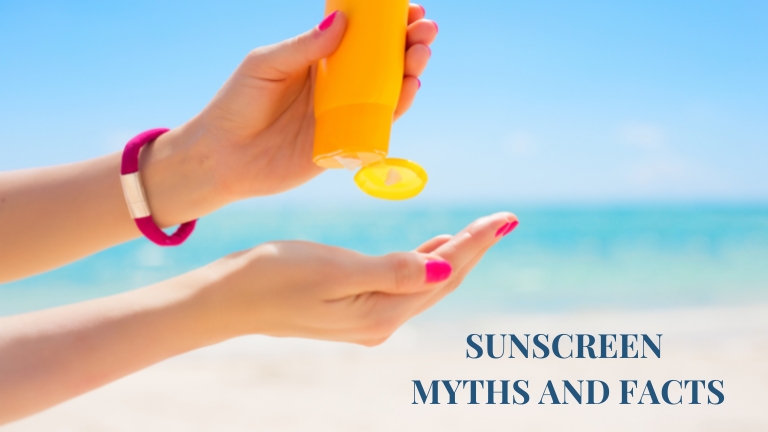
Everyone is aware of how crucial it is to use sunscreen to protect their skin, but do you know the justification about this? We should use sunscreen to protect ourselves from harmful UV rays because our skin works to shield us from them. But do you really need to wear it constantly? And does it matter if it’s raining? Let’s dispel the myths and examine the reality of sunscreen use.
Understanding sunscreen myths needs a basic knowledge of UVA and UVB light. They are both types of ultraviolet (UV) light that can cause skin damage after long-term exposure.
UVA light has a wavelength that penetrates the dermis, the thickest layer of skin. Unprotected UVA light exposure can cause skin aging, wrinkles, and a reduced immune system.
UVB rays have a shorter wavelength and are mostly responsible for sunburn, which is the burning of the skin’s top layer. UVB can cause the growth of skin cancer, and sunburns can cause lasting damage over time.
Some people feel that those with darker skin need not use sunscreen. This is because melanin acts to filter UVB rays and may, to some extent, protect against sunburn.
Even though persons with darker skin are better protected from the sun, they should still use a broad-spectrum sunscreen. UVA damage is not blocked in the same way by melanin and can cause premature skin aging and wrinkles.
Melanin will also not protect the skin from excessive sun exposure, such as spending long periods of time in the sun without protection. People with darker skin are also not protected to skin cancer.
A certain amount of sun protection may be supported by cosmetics, it is small and does not serve as a suitable replacement for sunscreen.
Makeup should be treated as a supplementary layer of protection, not the main layer of protection.
Many people believe that sunscreen is only required when their full body is exposed to sunshine, such as when swimming in the sea or at the pool. No matter how much of the skin is exposed, UV light is still harmful.
Some people believe that sunscreen is unnecessary on cloudy and rainy days since the sun does not feel as powerful as it does on sunlight. The truth is that the body is exposed to UV rays whenever it is exposed to sunlight, even on a cloudy day.
Lower arms and faces are frequently left exposed during the day, which increases their risk of sun damage.
Vitamin D is an essential nutrient for human health, and it is easily created by the body when exposed to UV rays. Sunscreen, on the other hand, blocks UV radiation. In principle, wearing sunscreen all of the time would prohibit a person from acquiring enough vitamin D.
However, sunlight can pass through clothing, sunscreens lose over time, and it is possible that a person will forget to apply sunscreen every time they see the sun.
It’s easy to believe that putting on sunscreen protects you from exposure to the sun. Many people who wear sunscreen believe that it keeps them safe throughout the day, even if a large portion of their skin is exposed.
The truth is that covering up the skin provides additional safety than sunscreen. Long-brimmed caps and clothes provide better skin protection than sunscreen.
Sunscreen actually protects from UVA and UVB radiation, although it may not fully protect the body. Even if sunscreen is used multiple times throughout the day, it is still possible to get a tan.
A tan is the body’s natural protection against UV exposure. Apply sunscreen and cover up with a hat and long clothing to avoid getting a tan.
There is a common misunderstanding that all sunscreen is basically the same and will do the same function. Sunscreens, on the other hand, contain a number of ingredients that may protect against different levels of UV exposure.
To block out UVA and UVB rays, active ingredients like as titanium dioxide, zinc oxide, and ecamsule are frequently employed. Chemical blockers, such as avobenzone, are also present. These ingredients all work in different ways to block the sun.
Sunscreen that is advertised as water-resistant or sweat-resistant, or that is marketed as sports sunscreen, may appear to be waterproof. Sadly, this is an overestimate of the advantages of sunscreen.
No sunscreen can be completely waterproof. After being in the water, people should always apply a water-resistant sunscreen. Allow sunscreen to dry for at least 10 to 15 minutes before going into the water.
Understanding the facts behind these misunderstandings might help people use sunscreen more effectively.
Each sunscreen has different recommendations, and people should follow the guidelines on the label for the best protection. Sunscreen use can help protect against skin damage and sunburn.
To read more interesting articles in the field of beauty and personal care, follow Nainlab.
©2023 Nainlab | All Rights Reserved | Web Design Service by Aarav Infotech

Join us on a journey of innovation, quality, and beauty transformation.
Discover the future of cosmetics with Nainlab.
©2023 Nainlab | All Rights Reserved | Web Design Service by Aarav Infotech

Discover the future of cosmetics with Nainlab.
©2023 Nainlab | All Rights Reserved | Web Design Service by Aarav Infotech
WhatsApp us